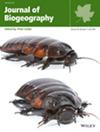Arctic-Boreal Bryophyte Dynamics Since the Last Glacial Inferred From Ancient DNA Metabarcoding
Abstract
Aim
This study investigates the main changes in bryophyte diversity and composition during the last 30,000 years in arctic and boreal ecosystems. Turnover in biological and ecological trait compositions of recorded bryophytes is assessed to explore changes in dominant life-strategies and habitats.
Location
The study area covers Siberia and Alaska (55°–90° N, 50°–150° E and 40°–90° N, 150° E-140° W).
Taxon
Bryophytes.
Methods
We leveraged a dataset of plant DNA metabarcoding (chloroplast, trnL) of sedimentary ancient DNA from 26 lake sediment cores. Our statistical analyses only target DNA reads assigned to bryophytes.
Results
A total of 120 amplicon sequence variants were obtained, which could be assigned 100% to bryophyte taxa. Our results indicate that the dominant families in the palaeo-record reflect well the dominant families observed in Siberia and Alaska, and compositional changes reflect mainly the modern latitudinal gradient. For example, Sphagnum shows a clear post-glacial expansion pattern. Richness was high in times of high habitat diversity. Our data reveal a turnover from biological traits characteristic of an r-strategy (colonists/short-lived, small size, monoicous, long sporophyte season, small spores) during the glacial towards a K-strategy (long-lived, large size, dioicous, short sporophyte season, large spores) during the Holocene. The ecological traits indicate a shift towards taxa with a preference for high summer temperature, forested habitats, soil acidity and wetlands.
Main Conclusions
Our results indicated substantial changes in the diversity and taxonomic composition, and dominant biological and ecological traits of bryophyte communities along with past warming and related habitat changes at the transition from glacial period to Holocene. This may to some extent represent an analogue for ongoing ecological change in northern high latitudes. Leveraging bryophyte records in sedimentary ancient DNA reveals promising results which could be enhanced once bryophyte representation in biodiversity and genetic databases has increased and bryophyte-specific ancient DNA methods become established.


 求助内容:
求助内容: 应助结果提醒方式:
应助结果提醒方式:


